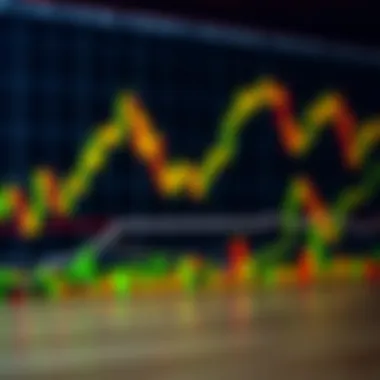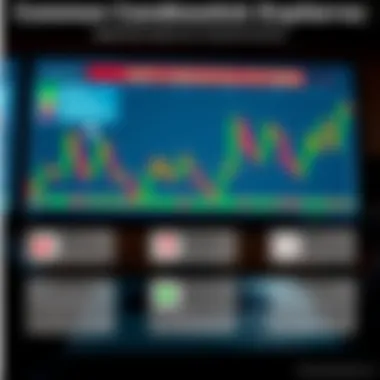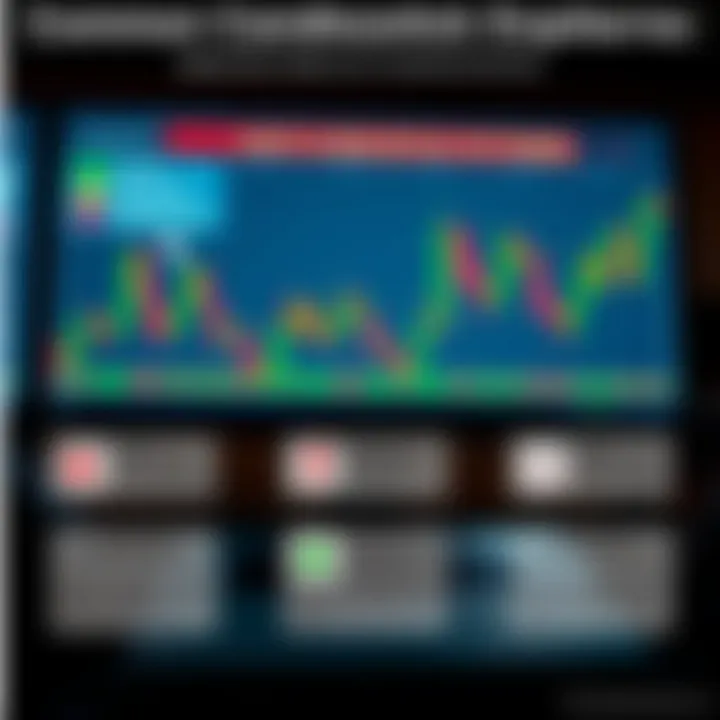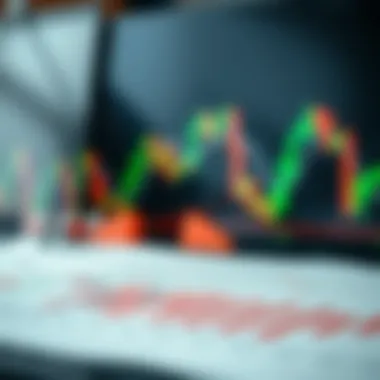Mastering Candlestick Patterns for Investment Success


Investment Dictionary
Understanding the lexicon of candlestick patterns can significantly enhance an investor's ability to navigate the often tumultuous waters of the financial markets. To grasp the core essence of these patterns, it is vital to familiarize oneself with key terms and investment strategies.
Key Terms and Definitions
- Candlestick Chart: A visual representation of price movements over a specific timeframe, combining opening, closing, high, and low prices.
- Bullish Candle: Indicated by a filled or colored body, showing the price closed higher than it opened, signifying buying pressure.
- Bearish Candle: Represented by a hollow or colorless body, where the close is lower than the open, indicating selling pressure.
- Wick: The thin lines extending above and below the body of the candlestick, showcasing the highest and lowest prices during the period.
- Doji: A formation indicating indecision in the market, characterized by a very small body where open and close prices are nearly the same.
Familiarizing oneself with these terms sets the groundwork for deeper interpretations of market sentiment and trends.
Common Investment Strategies
Investors often implement various strategies using candlestick patterns to augment their decision-making process. Here are some commonly applied strategies:
- Trend Following: Traders look for signals that align with the current market trend. For instance, a series of bullish candles may indicate a strong upward trend.
- Reversal Patterns: Certain patterns, such as the hammer or shooting star, are used to predict potential reversals in the market trend. This can help investors make timely buys or sells, avoiding losses.
- Swing Trading: This involves capturing short-term market moves. Utilizing candlestick formations can signal potential entry and exit points strategically.
By integrating these strategies with a solid understanding of candlestick formations, investors can develop a more nuanced view of market conditions, leading to potentially better trading outcomes.
Expert Advice
As one delves deeper into the intricate dance of candlestick patterns, adopting tailored investment strategies becomes essential.
Tailored Investment Strategies
Investors should consider personal financial goals and risk tolerance while crafting their approaches. Here are a few tailored strategies:
- Long-term Investment: For those with a patience-based strategy, focusing on major candlestick formations and significant trends over time can yield beneficial results. This approach might involve identifying multi-week bullish or bearish formations that indicate solid market shifts.
- Short-term Trading: If quick profits are on the agenda, align trades with daily or hourly candlestick patterns. Look for volatile formations that suggest rapid price movements, such as the engulfing pattern or morning star.
- Diversification: No matter the strategy, avoiding putting all eggs in one basket is crucial. Utilize candlestick analysis across different asset classes to hedge against market risks.
Risk Assessment and Management
Understanding and managing risk is paramount in trading. Investors can effectively utilize candlestick patterns to assess potential risks:
- Use stop-loss orders strategically around key support and resistance levels identified through candle analysis.
- Regularly review and adjust positions based on changing market conditions as indicated by new candlestick formations.
- Continuously educate oneself about market trends and patterns; knowledge is an investor's best ally.
"The market does not remember your losses, but it will remember your gains. Pay attention to the patterns!"
In summary, grasping candlestick patterns is more than just technical analysis; it’s about developing a mentality of adaptability and awareness. The right knowledge and strategies can make a world of difference in an investor's journey in the financial landscape.
Foreword to Candlestick Patterns
In the fast-paced world of financial markets, investors often find themselves sifting through rows of numbers and bar charts, trying to decipher where the market might move next. This is where candlestick patterns come into play—offering a visual clue to market sentiment that can be pivotal for informed decision-making. The intricate art of reading candlesticks is not just about knowing how they look; it's about understanding what they signify within the framework of market behavior.
Candlestick patterns are the foundation of technical analysis. They provide insights beyond raw price data, reflecting the psychological states of the market participants. By examining these patterns, one can gauge whether buyers or sellers are gaining the upper hand, which can assist in predicting future price movements.
Historical Background of Candlestick Analysis
Candlestick charting is an ancient practice that dates back to Japanese rice traders in the 18th century. This method quickly spread to other kinds of trading markets because of its effectiveness in depicting market trends and price extremes. Munehisa Homma, who is considered a pioneer in stock trading techniques, understood the importance of visual data well before the advent of modern technology. The candlestick system allows traders to condense a plethora of information into a single visual representation, combining price movements of open, close, high, and low within a specific time frame. This multilayered view enhances one's analytical capabilities, thus making well-informed trading decisions more achievable.
Understanding how candlestick patterns evolved helps today’s investors appreciate their fundamental significance in modern financial markets. It's a historical tool that has stood the test of time, adapted for today’s commodities, forex, and stock trading environments.
Importance of Candlestick Patterns in Trading
The merit of integrating candlestick patterns into trading strategies cannot be overstated. These patterns are not just aesthetically pleasing; they serve a crucial role in capturing the market's sentiments. Whether one is a day trader or a long-term investor, recognizing these patterns can be beneficial.
Identifying bullish or bearish trends through candlestick formations allows traders to make timely decisions, thus maximizing their potential for profit while minimizing losses. Moreover, these patterns assist in identifying potential reversal points in the market, which is invaluable for exit strategies.
“In trading, the goal is not to guess the future but to recognize the present.”
Candlestick patterns help facilitate this recognition.
In addition, candlestick analysis can confer advantages when combined with other technical indicators, enriching the trader's toolkit. It offers a sense of refinement and adaptability; market responses can be more easily anticipated, and execution can be more precise.
In sum, understanding candlestick patterns equips both novice and seasoned investors with a crucial skill set. These patterns are lenses through which the market can be interpreted, allowing for more strategic and informed financial decisions.
Components of Candlestick Charts
Candlestick charts serve as the backbone of technical analysis in trading, encapsulating a wealth of data in a visually engaging manner. Understanding the individual components of these charts is paramount for any investor looking to make informed decisions in the market. Each element of a candlestick conveys specific information about price movements, market sentiment, and potential future trends.
Understanding the Candlestick Body


The body of a candlestick is arguably the most critical part of the entire chart. It represents the price range between the opening and closing prices within a specified time frame. A long body indicates strong buying or selling pressure, while a short body often signifies indecision in the market.
- Bullish candles occur when the closing price is higher than the opening price, often depicted in green or white. This suggests buyer strength and an upward price movement.
- Bearish candles reflect a closing price lower than the opening price, shown in red or black, indicating selling pressure.
Investors look closely at the length of the body for insights. For instance, a lengthy bullish body following a series of bearish bodies could signify a reversal point, thereby suggesting a potential trend change.
Roles of Upper and Lower Shadows
Shadows, or wicks, protrude from the candle body and represent price extremes for a given time period. The upper shadow indicates the highest price reached, while the lower shadow shows the lowest price. Understanding shadows can provide significant insight into market sentiment.
- A long upper shadow could imply that buyers pushed the price up temporarily, but sellers ultimately took control before closing, signaling potential bearish activity.
- Conversely, a long lower shadow often suggests buyers are stepping in at lower prices, indicating potential support levels.
The presence or absence of shadows can dramatically change the interpretation of a candlestick. For example, a candle with little to no shadows—known colloquially as a "marubozu"—may indicate strong market conviction in that direction.
The Significance of Color in Candlesticks
The color of a candlestick offers important clues about market behavior that extend beyond mere price movements. While traders often focus on the opening and closing prices, the color also conveys emotional undercurrents in the market.
- Green or white candlesticks represent bullish sentiment, where bulls have taken charge, closing higher than where they opened.
- Red or black candles, in contrast, reflect bearish sentiment, indicating sellers' dominance, resulting in a lower close.
"Colors provide quick visual cues that can guide traders to make immediate decisions based on prevailing market trends."
Investors embrace these color signals, particularly when analyzing patterns in conjunction with other indicators. For example, a series of red candles that lead into a green candle can serve as an alert for a potential reversal point, drawing attention to a shift in momentum.
Basic Candlestick Patterns
Understanding basic candlestick patterns is crucial for any investor or trader looking to navigate the financial markets effectively. These patterns serve as visual tools that can indicate potential future price movements, giving traders an edge in making decisions. By recognizing various formations, traders can better align themselves with market sentiment and make strategic choices that can maximize returns.
These basic patterns are split into two categories: bullish and bearish. Knowing the distinction between them not only clarifies market behavior but also helps in developing a winning trading strategy. In addition, reversal and continuation patterns provide insights into possible changes in trend direction or the strengthening of existing trends, which is vital for timing entries and exits in trades.
Let's delve deeper into the specifics of these patterns.
Bullish and Bearish Patterns
Definition of Bullish Patterns
Bullish patterns are formations that suggest a potential price increase in an asset or security. These patterns often highlight a shift in market sentiment from selling pressure to buying momentum. The key characteristic of bullish patterns is the consolidation of buying activity, which culminates in a breakout above a resistance level. Investors often favor these patterns because they can indicate an opportune moment to buy, leading to profits as prices rise.
A common example of a bullish pattern is the "hammer," which appears at the bottom of a downtrend. Its unique feature—a long lower shadow with a small body—indicates that buyers stepped in after sellers pushed the price down. The advantages of understanding bullish patterns are clear: they help investors identify potential reversals and align their positions in a favorable direction.
Definition of Bearish Patterns
Conversely, bearish patterns signal a potential price decline. These patterns indicate a shift from buying enthusiasm to selling overwhelm. This flip in market sentiment prompts traders to consider exiting their positions or entering short sales. A defining aspect of bearish patterns is the clear formation of lower highs and lower lows, often culminating in a break below a support level.
One typical bearish pattern is the "shooting star," which forms after a price advance. The distinctive feature of the shooting star is its long upper shadow coupled with a small body at the bottom, suggesting that buyers attempted to push prices higher but were ultimately overruled by sellers. Recognizing such patterns can provide a much-needed edge, signaling potential downtrends before they become evident to the broader market.
Reversal Patterns
Reversal patterns are fascinating as they indicate a potential change in trend direction. Understanding these formations is essential for identifying market turning points, which means greater opportunities for profit.
The Hammer
The hammer pattern appears during a downtrend and indicates a possible reversal upwards. Its key characteristic is the small body at the top of the candlestick and a long lower shadow, showing that buyers entered the market after sellers pushed prices down. This battle between buyers and sellers often means that a bullish trend may soon commence.
This pattern is beneficial to traders looking for signs of market strength. However, it’s crucial to consider context and volume; not all hammers signal reversals without confirmation from subsequent candlesticks or patterns.
The Shooting Star
The shooting star serves as a bearish reversal pattern. It typically forms after an upward price movement, displaying a small body at the bottom with an extended upper shadow. This formation highlights that despite the initial buying pressure, sellers intervened and pushed the price down, indicating potential weakness in the upward trend.
This pattern is advantageous for traders focusing on short positions. However, it's essential to validate the shooting star with subsequent bearish action to confirm the trend change, as isolated patterns can be misleading.
Engulfing Patterns
Engulfing patterns involve two candlesticks where the second candle entirely engulfs the body of the first. A bullish engulfing pattern occurs when a small bearish candle is followed by a larger bullish candle, suggesting a strong reversal. On the flip side, a bearish engulfing pattern presents a larger bearish candle engulfing a previous bullish candle, indicating the end of an uptrend.
The unique feature of engulfing patterns lies in their strength: they typically demonstrate a decisive shift in momentum. However, the timing of entry remains critical; it’s recommended to wait for confirmation before acting on these signals.


Continuation Patterns
Continuation patterns suggest that a trend will likely persist. Identifying these formations can be particularly useful for traders looking to capitalize on an ongoing trend.
The Doji
The Doji is characterized by its nearly equal open and close prices, creating a cross-like shape. This pattern signifies indecision in the market, where buyers and sellers are in a stand-off. While Doji patterns can indicate a potential reversal, they often contextualize trends. Sometimes, a Doji can precede a breakout in the prevailing direction of the trend, making it a powerful indicator.
The Inside Bar
An inside bar pattern consists of a smaller bar contained within the previous bar’s range, signaling consolidation. The importance of this pattern is that it suggests traders are waiting for a decisive move. For traders, entering after a breakout from the range can align their trades with the existing trend, often resulting in favorable outcomes.
The Flag
Flags are continuation patterns that resemble a small rectangle or parallelogram angled against the prevailing trend. They indicate a pause before the trend resumes. Flags offer traders a chance to enter the market during relatively calm periods before a continuation of movement. Understanding this pattern can enhance overall strategy by timing entries more effectively.
Identifying and understanding basic candlestick patterns allows traders to read market sentiment and act with greater confidence. By applying this knowledge, investors can better position themselves for upcoming market movements.
Advanced Candlestick Patterns
In the realm of trading, recognizing and understanding advanced candlestick patterns can set a trader apart from the crowd. These patterns intensify the dialogue that basic strategies initiate. For both burgeoning and seasoned investors, diving intoadvanced candlestick formations illuminates nuances that can provide critical insights into market psychology. Knowing these can nab unobserved opportunities and shield against potential pitfalls.
Complex Reversal Patterns
The Evening Star
The Evening Star is a well-respected formation within the candlestick community that signals a possible trend reversal from bullish to bearish. This pattern, generally appearing at the peak of an upward trend, consists of three distinct candles: a strong bullish candle, a smaller indecision candle (which can be either bullish or bearish), and then a bearish candle that closes well into the body of the first one.
The key characteristic of the Evening Star is its ability to provide traders with a clear warning sign. This pattern suggests that buyers are starting to relinquish control, creating an opportunity for savvy investors to examine their bullish positions. One unique feature is its visual simplicity; the stark contrast in the candle bodies communicates a shift in sentiment that may be hard to ignore.
However, one must tread cautiously. The Evening Star's reliability can dwindle during erratic market conditions. This means incoming news or economic shifts could readily influence the effectiveness of this pattern, sometimes leading investors to make hasty decisions based on incomplete information. So, while it's a beneficial pattern, one should not rely solely on it without further supporting evidence from other indicators.
The Morning Star
In contrast to its evening counterpart, the Morning Star is the beacon of hope for traders aiming to catch the first whiff of a bullish trend following a decline. This pattern is recognized by three components: a bearish candle, a smaller indecisive candle, and a strong bullish candle that ideally closes above the midpoint of the first candle.
The Morning Star’s importance lies in its power to signal a potential bottom in the market. For traders who seek entries at lower prices, this pattern provides a concrete signal that a reversal may be dawning. A remarkable aspect is that it evokes a sense of renewed optimism, as buyers demonstrate their readiness to wrestle control away from sellers.
However, it is important not to get carried away. A false signal can occur if the bullish candle fails to stand strong or if the market quickly reverses again. While the Morning Star can provide powerful insights when accompanied by supportive factors, traders must exercise caution, as misplaced enthusiasm can lead to significant losses.
Combination Patterns
The Three Black Crows
A striking formation, the Three Black Crows pattern indicates a sustained bearish trend. It comprises three sequential bearish candles, each closing lower than the previous day’s close. This relentless descent signifies aggressive selling pressure and a loss of confidence among buyers. What makes this pattern noteworthy is its sheer cadence—an unyielding series of declines that illustrates the momentum behind a negative shift.
For investors seeking to capitalize on bearish trends, detection of the Three Black Crows can serve as an alarm bell. It is especially potent in a high-volume context, as this underscores the weight of the selling behavior. However, caution is warranted; market fluctuations and external economic factors can sometimes skew perceptions, turning a valid observation into a hasty reaction. Better understanding the context surrounding this pattern often proves invaluable.
The Three White Soldiers
On the flip side, the Three White Soldiers provides a compelling case for bullish sentiment. It consists of three consecutive bullish candles that open within the body of the previous candle and close progressively higher. A primary characteristic of this pattern is that it often signifies strong rebound potential after a downtrend.
This pattern often attracts traders who are alert to signs of recovery and are looking to reposition themselves for gains in favorable conditions. The Three White Soldiers makes it easy to recognize that optimism is building and buyers are increasingly confident. Nevertheless, investors must remain vigilant; if underlying economic fundamentals do not support the bullish move, this apparent strength could evaporate rapidly, leading to an abrupt and unpleasant reversal.
In summary, advanced candlestick patterns, particularly these complex configurations, provide significant insights into market behaviors. Yet, they are most effective when used in conjunction with other analytical tools and proper risk management strategies. Real mastery emerges from the ability to interpret these patterns harmoniously with economic contexts and external factors.
Interpreting Candlestick Patterns
Interpreting candlestick patterns is where the rubber meets the road for many investors. It's not simply about recognizing shapes on a chart; it’s an essential skill that can significantly influence trading decisions. Understanding these patterns helps traders gauge market sentiment and make predictions about potential price movements. The importance of interpreting these patterns lies in their ability to inform one’s trading strategy, enhance risk management, and bolster overall market awareness.
Analyzing Trend Strength
When examining candlestick patterns, one has to look closely at trend strength. A single candlestick can indicate a price movement; however, it’s the combination of multiple candlesticks that tells the full story. To assess trend strength, traders typically use a few key indicators:
- Length of the Candlestick Body: A longer body generally signals a stronger movement, whether bullish or bearish. For example, if a green candle (indicating uptrend) is significantly longer than previous ones, it suggests considerable buying momentum.
- Consecutive Candles in the Same Direction: If you see a series of bullish candles following one another, it’s a strong sign that buyers are predominantly in control of the market. Conversely, several bearish candles indicate selling pressure.
- Volume: High volume during these trends adds another layer of credibility. It’s not just about moving up or down; it’s about whether that movement is supported by robust trading activity.
Understanding trend strength is crucial for timing entries and exits. A trader who can discern whether a trend is gaining or losing steam can make informed decisions, reducing the likelihood of entering too late or exiting too early.
Contextual Analysis with Technical Indicators
Candlestick patterns become much more powerful when analyzed with other technical indicators. This combination allows for a more nuanced approach to trading decisions. Here are some ways to integrate these tools effectively:
- Moving Averages: By overlaying moving averages on candlestick charts, traders can determine the overall direction of the market. For instance, if prices are above a moving average, it typically suggests an upward trend, whereas prices below indicate a downward trend.
- Relative Strength Index (RSI): This momentum oscillator helps ascertain whether an asset is overbought or oversold. If candlestick patterns suggest a bullish reversal and the RSI is below 30, it may confirm a buy signal.
- Bollinger Bands: When prices approach the lower band, it often suggests oversold conditions. Combined with bullish candlestick patterns, it can signal an impending reversal.
By blending candlestick analysis with other indicators, traders can enhance their decision-making framework. It’s about building a robust strategy that leverages multiple perspectives, allowing for a clearer picture of market dynamics.


Integrating different analytical tools with candlestick patterns not only strengthens predictions but also helps reduce emotional biases in trading, making decisions based on data rather than instinct.
In essence, mastering the interpretation of candlestick patterns involves understanding their role in trend analysis and being able to contextualize them alongside technical indicators. This skill set provides traders with a comprehensive toolset to navigate the often-turbulent waters of financial markets.
Practical Application of Candlestick Patterns
Candlestick patterns play a pivotal role in trading strategies, serving as essential indicators for investors navigating the often choppy waters of the financial markets. The practical application of these patterns goes beyond mere candle observation; it's about integrating them into a broader strategy that enhances decision-making and profitability. Understanding how to effectively utilize candlestick patterns is not just beneficial, but crucial for any investor looking to sharpen their market edge.
Integrating Patterns into Trading Strategies
When investors think about integrating candlestick patterns into their trading strategies, it's vital to remember that these patterns are not standalone tools. They work best in conjunction with other indicators and analyses. Here’s how you can weave these patterns into your trading approaches:
- Trend Following: Candlestick patterns can help identify the prevailing market trend. For example, recognizing a series of bullish candlesticks may suggest a bullish trend, prompting you to consider a long position. Conversely, bearish patterns may signal an opportunity to sell or short.
- Entry and Exit Points: Patterns like the Engulfing or Doji can indicate optimal entry or exit points. A well-timed entry based on a confirmed signal can maximize your potential profits while minimizing losses.
- Personalization: Consider your risk appetite and trading style. Are you a scalper eyeing quick gains, or a long-term trader? Depending on your answer, you may favor different candlestick patterns.
A trader once said, "It's not just about reading patterns; it's about feeling the market pulse." This sentiment captures the essence of integrating candlesticks into a broader strategy.
- Backtesting: Before implementing candlestick strategies in live trading, it's prudent to backtest them using historical data. This can illuminate how specific patterns had performed under various market conditions, providing insights into their effectiveness.
Risk Management Techniques
Even the best strategies are only as effective as the risk management techniques behind them. When it comes to candlestick patterns, the following risk management strategies can make a difference:
- Setting Stop-Loss Orders: Using candlestick patterns to define your stop-loss can protect your investment. For instance, if you enter a trade following a confirmed bullish pattern, placing a stop-loss slightly below the last significant low can help minimize potential losses.
- Position Sizing: It’s crucial to determine how much capital to allocate to each trade. Candlestick patterns can help decide how aggressive or conservative your position should be based on the reliability of the patterns observed.
- Diversification: Avoid putting all your eggs in one basket. Use candlestick patterns across different assets to spread your risk. Different patterns may perform variably across asset classes or market conditions, so a diverse portfolio can cushion against volatility.
- Review and Adjust: Regularly review your performance. As you become more accustomed to interpreting candlestick patterns, you may discover that some strategies are more effective than others. Be flexible and willing to adjust accordingly.
In summary, the practical application of candlestick patterns goes far beyond recognition; it involves integrating these insights into a robust trading strategy while ensuring that sound risk management practices are in place. By recognizing patterns and effectively managing risk, investors enhance their chances for success in the unpredictable world of trading.
For more comprehensive insights on trading strategies, consider exploring resources on Investopedia or Wikipedia.
Common Misconceptions about Candlestick Patterns
Understanding the various myths and misunderstandings surrounding candlestick patterns is vital for anyone looking to make informed trading decisions. Misconceptions can easily lead investors astray or create insecurity in their strategies. By identifying these myths, individuals can foster a clearer understanding of what candlestick patterns genuinely represent and how they can be effectively employed in trading strategies. This section will decode common myths while highlighting the need for a balanced perspective when utilizing these tools.
Myth vs. Reality
One prominent myth that tends to linger is the idea that candlestick patterns are foolproof indicators of market movement. Many traders believe that a single bullish candlestick automatically predicts rising prices. This is simply not how the market functions.
Reality: Candlestick patterns, while informative, are not guarantees. They are tools that provide insights based on historical data and market sentiment. For instance, the appearance of a doji might signal indecision in the market, but without considering the broader context such as volume and other price movements, one can easily misinterpret its significance. Experienced traders often say, "No signal stands alone"; hence, integrating multiple forms of analysis is prudent.
Here are a few common candlestick myths contrasted with their realities:
- Myth: All patterns predicted in textbooks will appear in every market.
- Myth: Longer candlestick bodies mean a more significant effect on the market.
- Reality: Market dynamics differ widely. Historical patterns might replicate occasionally, but they do not assure future performance.
- Reality: While longer bodies can indicate strong movement, the market might still reverse before a trader can react.
This acknowledgment of myth vs. reality not only enhances understanding but also promotes a more analytical and cautious approach to trading.
Over-Reliance on Patterns
Another common pitfall is the tendency to rely excessively on candlestick patterns as the primary basis for decisions. It's easy to see a striking formation and jump to conclusions without looking at other factors. Patterns may be clear, but overconfidence can lead to serious missteps.
Traders might look at a classic pattern, such as the morning star, filled with enthusiasm and forget essential markers like support and resistance levels. This blind faith can transform a hopeful trader into a casualty of the market. Relying solely on these patterns often neglects important market contexts, like economic news or global events.
To avoid falling into this trap, consider:
- Diversified Analysis: Combine candlestick patterns with other technical indicators. Use moving averages or RSI to corroborate the signals you see.
- Market Sentiment: Look beyond the charts. Keep abreast of current events that may impact market behavior.
Traders should remind themselves that while candlestick patterns are valuable, they are just a piece of a much larger puzzle. Over-reliance on any single method can leave an investor exposed to unforeseen market shifts.
Trading based on a comprehensive overview, including fundamental analysis, technical indicators, and a proper understanding of candlestick patterns, leads to better decision-making.
Ending
In the realm of trading and investment, grasping the nuances of candlestick patterns can substantially elevate one's understanding of market dynamics. This article has navigated through multiple facets of candlestick charts, emphasizing why these visual representations are not merely artistic but hold significant analytical power.
The Value of Candlestick Analysis in Modern Trading
One might wonder, in a world buzzing with complex algorithms and high-frequency trading, why should anyone bother with candlestick patterns? Well, here lies the crux. These patterns serve as a bridge between raw data and actionable insights. They convert noise into structure, providing clarity when it’s most needed.
The benefits of candlestick analysis extend beyond just observing the patterns. For individual investors and financial enthusiasts alike, these patterns simplify intricate price movements into understandable storytelling. Each candlestick reflects trader sentiment during a specific timeframe, capturing the battles between buyers and sellers. This reflected emotion can be crucial for predicting future price actions.
Consider the following elements that define the value of candlestick analysis:
- Flexibility: Candlestick patterns can be applied in all time frames, whether one is trading on a 5-minute chart or an hourly scale. This versatility makes them essential across different trading strategies.
- Integration with Other Tools: Many traders combine candlestick analysis with other technical indicators, such as moving averages or trend lines, creating a more robust trading framework.
- Immediate Insight: Patterns like the Doji or Engulfing can indicate a shift in momentum almost instantly. Being positioned to interpret these changes quickly can be the difference between seizing an opportunity or missing one altogether.
- Visual Simplicity: While many indicators may overwhelm the eye with lines and numbers, candlestick charts present information in a digestible format. This visual simplicity aids in retention and understanding of market movements.



